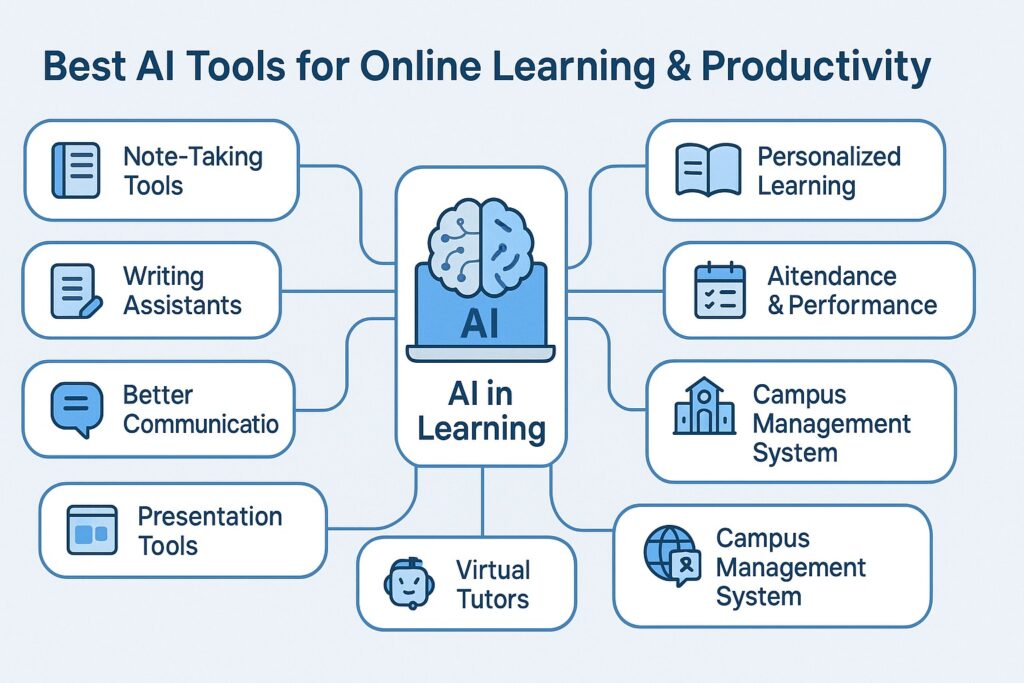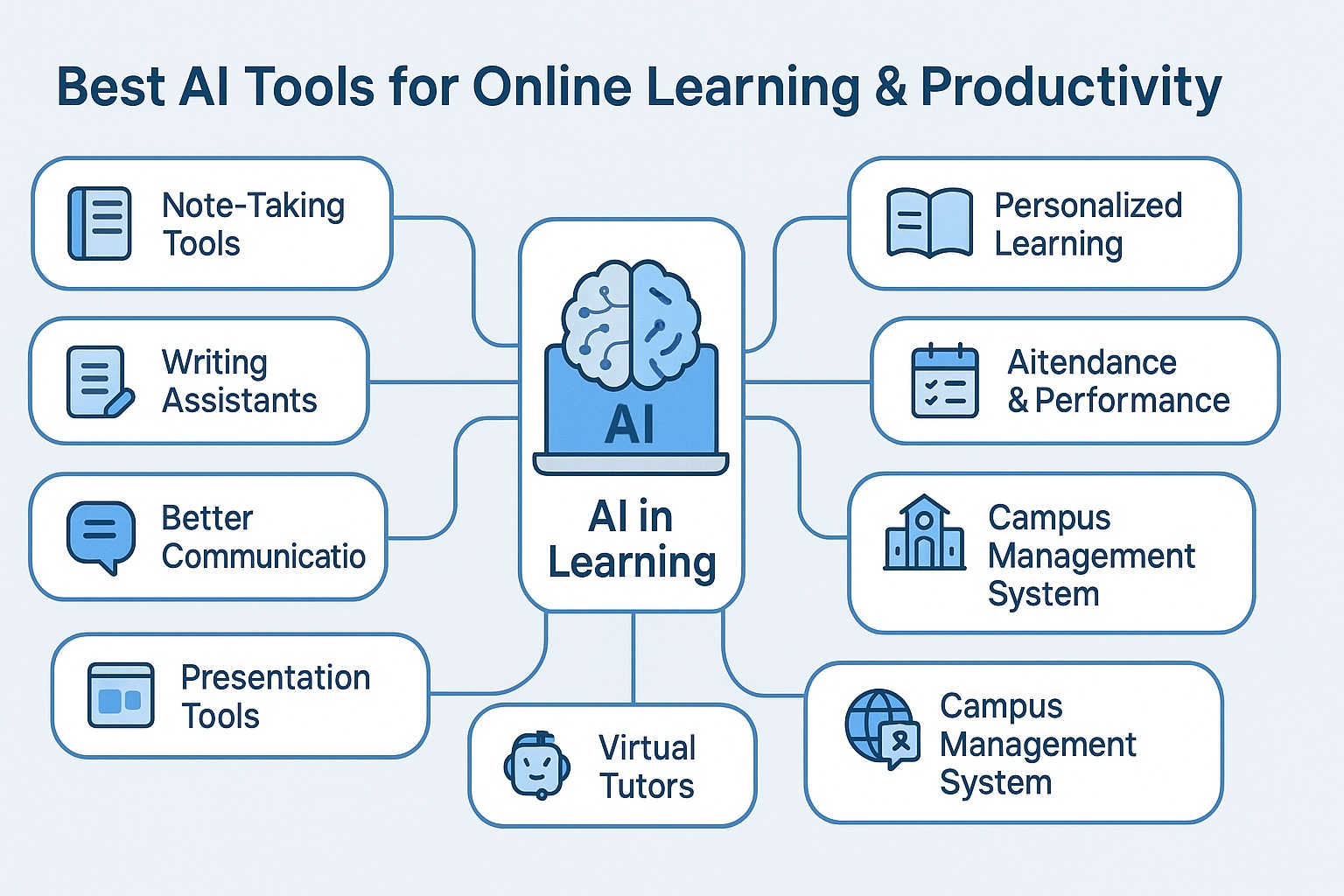The current fast changing educational environment has rendered smart learning tools a necessity in improving the academic output of both the student and the teacher. These tools are transforming the way the learning process is occurring in schools, colleges and universities, either by simplifying the communication process or automating the administrative process.

Student management systems and other online tools have helped institutions to better manage course work, student attendance, grading, and communication to grant further time to educators to teach and students to learn.
We will discuss some of the best smart learning tools that are changing the face of productivity in contemporary education.
1. Learning Management Systems (LMS)
These sites have turned into the support of online learning.
- Centralized content delivery: Lecture notes, videos, assignments and assessments can be viewed in the same location.
- 24/7: Facilitates self-directed and flexible learning.
- Performance tracking: Teachers will be able to track the progress and change the teaching strategies.
- Moodle, Canvas, Blackboard and Google Classroom are popular tools.
2. AI Powered Learning Systems
AI has opened a new dimension of individualization in education.
- Adaptive learning paths: Students are presented with content that is tailored to their preferences and performance.
- Real-time feedback: AI is capable of scoring quizzes and providing real-time performance feedback.
- Chatbot support: AI assistants offer 24/7 academic assistance on questions and resources.
Examples: adaptive testing at Khan Academy, Socratic by Google and Querium.
3. Note-Taking and Organization Apps Digital
The effectiveness in taking notes and organization will come in handy in making one more productive by saving time and reducing clutter.
- Digital notebooks: Some tools like Evernote, Notion, and OneNote may help students to divide their notes into subjects.
- Smart tags and searchability: Find the previous notes easily without turning the pages.
- Multi-device sync: Read notes on the tablet, mobile, or laptop-anywhere.
4. Time Management and Focus Tools
- The secret to school success is time management.
- Study timers and Pomodoro tools: apps like Forest or Focus Booster can be helpful to ensure that students are focused during the time they are studying.
- Task planners: Todoist and MyStudyLife are applications that assist in breaking large projects down into small tasks.
- Integration with calendars: Add to Google or outlook calendar to stay on top of deadlines and exams.
5. Online Groupware.
Teamwork is a necessity particularly in group work and distance learning.
- Live document editing: Inc. Google Workspace (including Docs, Slides, and Sheets) allows two or more users to collaborate simultaneously.
- Virtual whiteboards: Miro and Jamboard.
- Video conferencing: Zoom, Microsoft Teams, and Meet are integrated and provide a virtual interaction without any problems.
6. Smart Assessment Tools
Assessment of students no longer has to be time consuming and stressful.
- Automated quizzes: Save time and provide grading on the spot.
- Interactive tests: Quizizz and Kahoot! are tools that allow more interactive assessment.
- Plagiarism checkers: Programs such as Turnitin and Grammarly promote academic honesty.
7. Online Libraries and Research Archives
Scholarly research and productivity is improved with access to quality learning material.
- E-books and online journals:The online sources such as JSTOR, Google Scholar, and ProjectMUSE are digital sources that provide a comprehensive range of academic materials.
- Search optimization: Intelligent algorithms assist students in locating authoritative sources in a short time.
- Reference management software: Programs such as Zotero and Mendeley can assist with reference management and formatting.
8. Classroom Engagement Tools
The engagement of students during the teaching sessions improves the learning in general.
Interactive polling, which is represented by Mentimeter and Poll Everywhere, among others, allows teachers to receive instant student feedback.
- Educational gamified environments, such as applications such as Duolingo and Quizlet, are attractive and immersive.
- Merge Cube and zSpace are examples of augmented reality technologies which can provide the user with an immersive learning experience.
9. Campus-Wide Integration Platforms
Software like Campus management systems and student attendance software are now being implemented in institutions as a way of consolidating and streamlining operations.
- A single dashboard: Students, teachers, and administrators will be able to access all the relevant information, namely admissions, fees, grading and scheduling, in one platform.
- Real-time data analytics: Assists in the monitoring of the trends in academics and the simultaneous enhancement of the performance of the institution.
- Mobile access: Mobile applications make all services available everywhere, at all times.
10. Inclusive Learning Assistive Technology
- Digital tools have continued to help students with special needs to enjoy equal access to education.
- Text- to- speech and speech-to- text technologies offer assistance to students who may have difficulties with reading or writing.
- Transcript services and closed captioning services also help the hearing-impaired students to follow the lectures better.
- Ginger, Kurzweil3000 and Read & write individualized interfaces may be customized to fit the needs of the individual learner.
11. Cloud Storage Solutions
Cloud tools make sure that students do not lose their valuable files ever again.
- Security Backup: Google Drive, Dropbox, and one drive are cloud-based systems that are used in storing data safely.
- Share without any trouble: It is possible to share the document, video or a project file instantly with fellow students or the teacher.
12. Coding and STEM Tools
Complex topics such as coding and STEM can also be used with smart tools to help students learn.
- Online coding environments: Scratch, Repl.it, Codecademy, and Khan Academy are online platforms that allow you to do real programming.
- STEM kits and simulators: Tools such as Tinkercad, Arduino, and PhET Simulations allow abstract concepts to be brought to real-life.
Final Thoughts
By providing:
- Automation of routine tasks.
- Individual and flexible learning.
- Availability of international education materials.
- Better cooperation and communication.
- Increased access to different learning requirements.
The implementation of these tools will allow schools, teachers, and students to spend more time in quality education and development and not be overwhelmed by the administration or logistical issues.
In conclusion:
You will find a smart learning tool, either as a teacher who needs to simplify your practice or as a student who needs to learn more effectively.
A seamless blend of technology, innovation, and smart systems is the second step in the academic productivity process that can not only streamline the learning process, but also make it smarter.















Leave a Reply